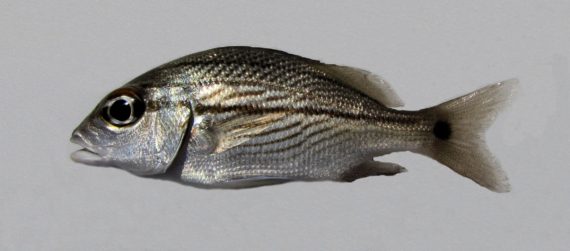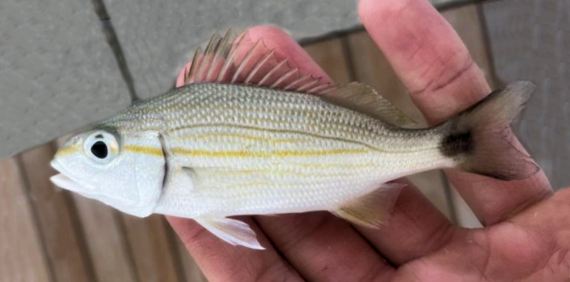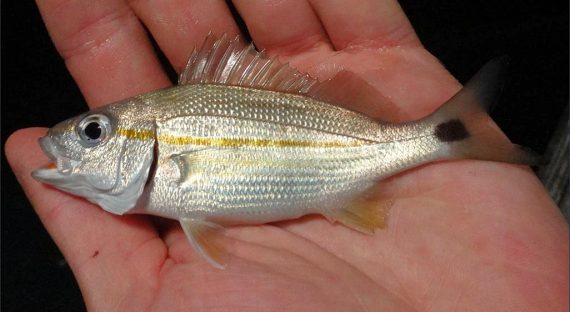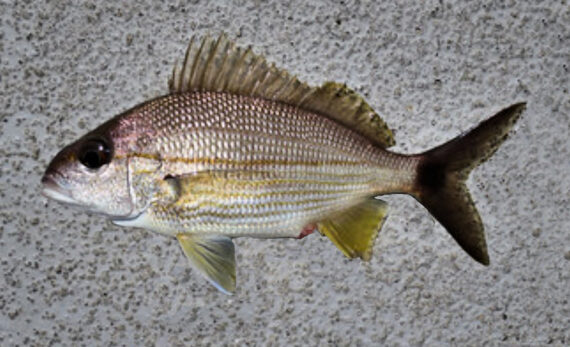Tomtate, Haemulon aurolinaeatum
 Tomtate, Haemulon aurolinaeatum, Juvenile. Fish caught out from coastal waters off Sugarloaf Key, Florida, August 2014. Length: 13 cm (5.1 inches). Photograph courtesy of Dean Kimberly, Atlanta, Georgia.
Tomtate, Haemulon aurolinaeatum, Juvenile. Fish caught out from coastal waters off Sugarloaf Key, Florida, August 2014. Length: 13 cm (5.1 inches). Photograph courtesy of Dean Kimberly, Atlanta, Georgia.
 Tomtate, Haemulon aurolinaeatum, Juvenile. Fish caught from coastal waters off Miami, Florida, February 2022. Length: 12 cm (4.7 inches). Catch, photograph and identification courtesy of James Lafontaine, Long Island, New York.
Tomtate, Haemulon aurolinaeatum, Juvenile. Fish caught from coastal waters off Miami, Florida, February 2022. Length: 12 cm (4.7 inches). Catch, photograph and identification courtesy of James Lafontaine, Long Island, New York.
 Tomtate, Haemulon aurolinaeatum. Fish caught out from coastal waters off Islamorada, Florida, April 2018. Length: 13 cm (5.1 inches). Catch, photograph and identification courtesy of Marc Eberlein, Grand Rapids, Michigan.
Tomtate, Haemulon aurolinaeatum. Fish caught out from coastal waters off Islamorada, Florida, April 2018. Length: 13 cm (5.1 inches). Catch, photograph and identification courtesy of Marc Eberlein, Grand Rapids, Michigan.
 Tomtate, Haemulon aurolinaeatum. Fish caught out from coastal waters off Fort Lauderdale, Florida, December 2013. Length: 14 cm (5.5 inches). Photograph courtesy of Ben Cantrell, San Diego, California.
Tomtate, Haemulon aurolinaeatum. Fish caught out from coastal waters off Fort Lauderdale, Florida, December 2013. Length: 14 cm (5.5 inches). Photograph courtesy of Ben Cantrell, San Diego, California.
 Tomtate, Haemulon aurolinaeatum. Fish caught out from coastal waters off Key West, Florida, December 2013. Length: 14 cm (5.5 inches). Catch, photograph, and identification courtesy of Josh Leisen (joshadventures.com), Gaylord, Michigan.
Tomtate, Haemulon aurolinaeatum. Fish caught out from coastal waters off Key West, Florida, December 2013. Length: 14 cm (5.5 inches). Catch, photograph, and identification courtesy of Josh Leisen (joshadventures.com), Gaylord, Michigan.
 Tomtate, Haemulon aurolinaeatum. Fish caught out from coastal waters off Galveston, Texas, October 2013. Length: 25 cm (9.8 inches). Catch, photograph and identification courtesy of Eli (obsessiveangling.wordpress.com).
Tomtate, Haemulon aurolinaeatum. Fish caught out from coastal waters off Galveston, Texas, October 2013. Length: 25 cm (9.8 inches). Catch, photograph and identification courtesy of Eli (obsessiveangling.wordpress.com).
 Tomtate, Haemulon aurolinaeatum. Fish caught from coastal waters off Sebastian, Florida, April 2021. Length: 16 cm (6.3 inches). Catch, photograph and identification courtesy of Ben Cantrell, Sebastian, Florida.
Tomtate, Haemulon aurolinaeatum. Fish caught from coastal waters off Sebastian, Florida, April 2021. Length: 16 cm (6.3 inches). Catch, photograph and identification courtesy of Ben Cantrell, Sebastian, Florida.
The Tomtate, Haemulon aurolineatum, is a member of the Grunt or Haemulidae Family, and is known in Mexico as ronco jeníguaro. Globally, there are twenty-one species in the genus Haemulon, and all twenty-one are found in Mexican waters, fourteen in the Atlantic and seven in the Pacific Ocean.
The Tomtate is one of the smallest grunts and has a long and thin body that has a depth that is 33% to 37% of standard length. They have an overall silver-white appearance and a horizontal yellow-brown stripe along the length of their body, which ends in a dark circle at the base of their tail. There is a second narrow stripe on their sides above the lateral line. The inside of their mouth is red and their anal and pelvic fins are yellowish. Their mouth is small and opens at a level below and ends before the eye. Their anal fin has 3 spines, the second and third being equal in size, and 9 rays; their caudal fin is notched; and, their dorsal fin has 12 to 14 spines and 14 to 15 rays. They have 24 to 28 gill rakers. They are covered with scales.
The Tomtate is found inshore around coral and rocky reefs at depths up to 30 m (100 feet). They reach a maximum of 25 cm (10 inches) in length. As of January 1, 2024, the International Game Fish Association world record stood at 0.56 kg (1 lb 4 oz) with the fish caught from coastal waters off Hatteras, North Carolina, in May 2006. They are bottom feeders that forage for amphipods, crabs, shrimp, snails, and worms as well as algae and plankton. In turn they are preyed upon by a wide variety of groupers, mackerel, and snappers. They are a schooling species and fairly tolerant of colder water common around offshore reefs and near platforms. They have live spans of up to nine years. The Tomtate is poorly studied with very limited information available about their lifestyle and behavioral patterns including specific details on age, growth, longevity, movement patterns, diet, habitat use, and reproduction.
The Tomtate is the widest ranging member of the Grunt Family and is found in the Western Atlantic along the coast of the United States, throughout the Caribbean, and south to Brazil. In Mexican waters the Tomtate is found in all waters of the Atlantic Ocean including the Gulf of Mexico and the Caribbean.
The Tomtate is similar to, and can easily be confused with, the juvenile Bluestriped Grunt, Haemulon sciurus, the French Grunt, Haemulon flavolineatum, and the White Grunt, Haemulon plumieri, all of which lose their tail spots with maturity.
From a conservation perspective the Tomtate is currently considered to be of Least Concern with stable, widely distributed populations. They caught with regularity by recreational anglers with light tackle on pieces of cut fish, shrimp, and squid. Although small in stature they are considered a good panfish. They are approachable and often seen by divers; they will provide a warning sign when larger fish approach as they scatter. They are heavily preyed upon by larger fish, making them an excellent live bait fish.